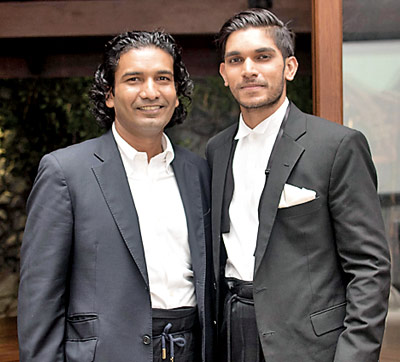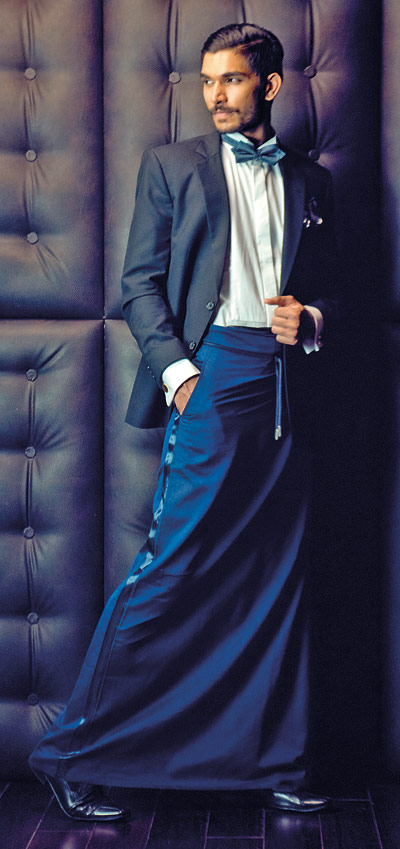Stand out in statement sarongs

Asanka and brand ambassador for the LOVI sarong
The lid comes off an elegant gift box to reveal a sarong, wrapped carefully in layers of tissue. To Asanka de Mel, its creator, this is not just any old sarong.
It is the result of months of experimenting and hard work—the re-invention of a traditional article of clothing as an item of elegant evening wear.
Thus, there’s his Tuxedo line, or the Little Black Sarong line for women. There’s another that involves patiently stitching hand-cut camel leather onto the fabric. Yet another showcases sarongs with sheer panels. The Printed Collection features bold, beautiful designs.
Every item has been carefully thought out in a product development process that cost Asanka close to Rs. 2 million. But the passion that drives him, he says, cannot be measured in rupees and cents.
His sarongs have two special features—pockets, to increase functionality, and a lining. He has applied for US patents for both.
“I always found it strange that there is no pocket on a sarong as there is in every other piece of men’s clothing,” Asanka smiled. “It’s hard to do anything involving activity.
If you’re sitting around it’s ok. But if you’re moving around, driving, or carrying a purse, you always have to hold your stuff—your phone, your wallet—in your hand,”
The sarongs are priced between Rs. 3,000 and Rs. 10,000. “I’m not interested in just creating a product,” he observed. “I’m interested in creating a brand, essentially the promise of an experience.

The formal look in a sarong with a pocket
The promise of an experience is more expensive than putting a pocket on a sarong.”
Asanka spent much of his adult life in Silicon Valley, San Francisco, as a Technology Executive—a most unlikely candidate for a fashion designer. He has now moved to Sri Lanka to promote his product among Sri Lankans under the ‘LOVI’ label.
“I was born and raised in Dehiwala,” the 42-year-old entrepreneur said. “I did my A/Levels at St. Peter’s College and started university at Katubedda.
But this was back in the day when there were frequent shutdowns so I applied to a university in the USA and received admission.”
Asanka worked in startups for over 15 years.
This gave his sufficient experience to venture out on his own. “A startup is essentially an organization that checks the feasibility of a new product or service,” he explained.
“It would test how to improve it, whether there is an opportunity to create a more engaging, more meaningful experience for the consumer of the product.”
But why sarongs? “I find it a comfortable garment,” he replies, simply. “And I think it’s one of the most authentic pieces of Sri Lankan clothing.
We have a stronger claim to sarongs than we would have to jeans, or corduroy or wool, for that matter. I think we can create an international brand around this. It has been in my mind for some time.”
Sarongs in Sri Lanka have not evolved over the decades. Asanka aspires to change that. “If you look at sarongs, they mostly have similar prints for the last fifteen or twenty years.
I see this as an opportunity to re-imagine everything, not just the pocket but how a sarong could be, could look. Why not leather on a sarong? Why not create something absolutely stunning?”
Today, Asanka still travels between San Francisco (interestingly, one of his sarongs even has the famous Golden Gate Bridge depicted on it) and Sri Lanka, where he has set up a design workshop.
“You have to look at opportunities that other people would not look at,” he said. “It’s not to say I will be one hundred percent successful. I know I am taking a lot of risk in doing this. But there is an opportunity.”
The sarong is important to Sri Lankans—according to a recent study by Survey Research Lanka, 70 percent of households have at least one family member who wears sarongs.
“Wearing a LOVI sarong is an authentic, bold statement about cultural identity,” Asanka says. “Especially within the new global ecosystem, we are all seeking to be part of that community and simultaneously stand out as unique.”

For women too: The ‘red poppy’ sarong
Even the name of the brand has been well thought out. “I wanted something approachable and easy to remember,” Asanka said. “Lovi is a fruit over here and the name sounds so much like ‘love’. It has the symmetry of a word that is beautiful.”
Startups are a lot of hard work involving considerable risk. “So you need to have a passion for what you do,” he explained. “Secondly, you must have an authentic claim to your product.
You must have an understanding of it that is uncharacteristic for others. For example, for the Scots, understanding wool and sweaters comes naturally; to me, not so much. The Italians understand cashmere a whole lot better than I do. It’s not to say I can’t learn it, but it takes time.”
“The third component is the amount of resources that go into what you create,” he said. “To ensure that the wearer or the person that is engaging with it can understand the level of craftsmanship that has been put together, and every single detail of it.”
Asanka’s target market is here but he is also aiming his products at Sri Lankans living abroad. “They are all brand ambassadors for a product like this,” he said. “I wanted to create something they could all be proud of.”


